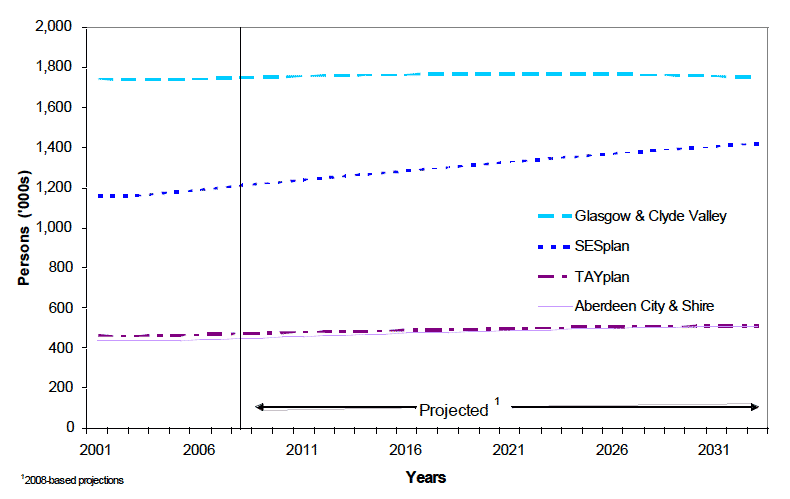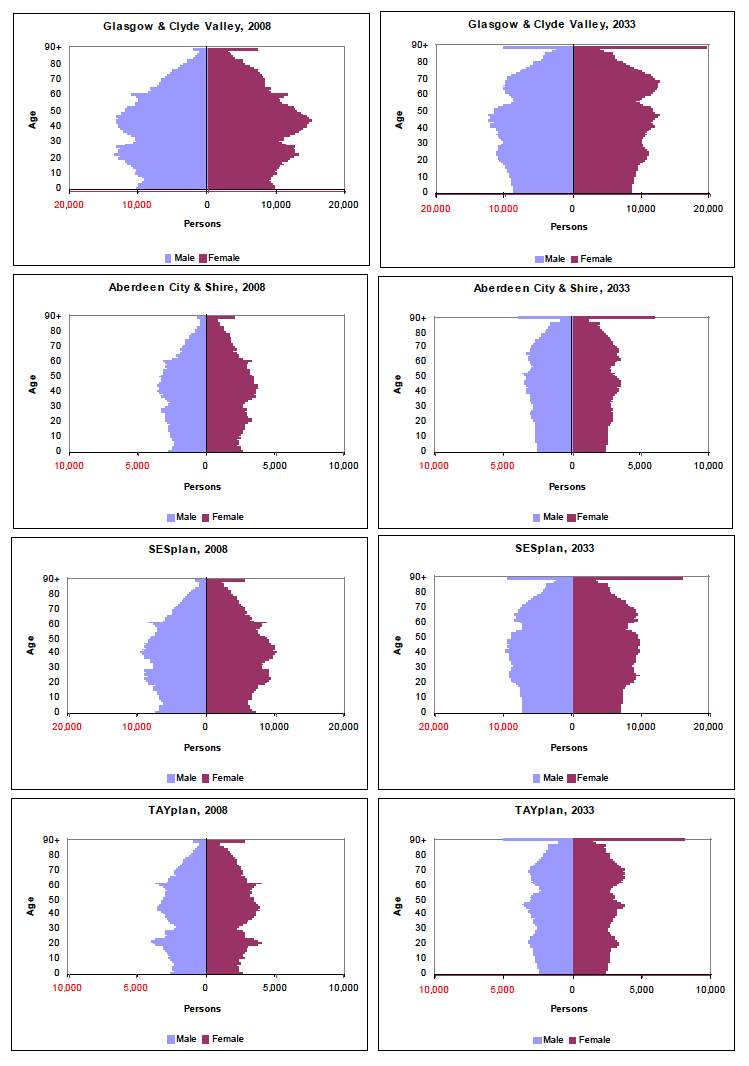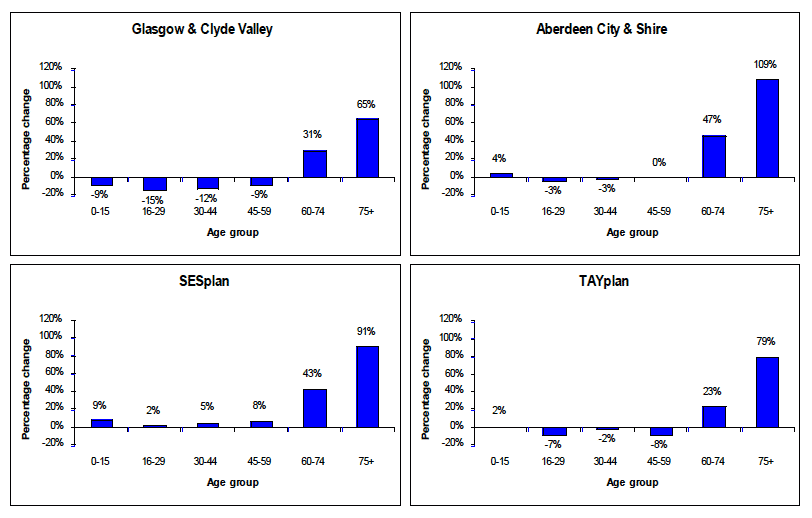
3.1 Main Points
The key points in this paper, relating to the Strategic Development Plan (SDP) areas, are:
Summary of percentage change in Population in Strategic Development Plan Areas
| Glasgow & Clyde Valley | Aberdeen City & Shire | SESplan | TAYplan | Scotland | |
|---|---|---|---|---|---|
| Population | 0% | 14% | 17% | 8% | 7% |
| Children (0-15) | -9% | 4% | 9% | 2% | -2% |
| Working Age3 | -4% | 7% | 13% | 2% | 2% |
| Pensionable Age4 | 23% | 48% | 38% | 28% | 31% |
3 Working age is 16-59 for women and 16-64 for men until 2010. Between 2010 and 2020 working age becomes 16-64 for women. Between 2024 and 2026, working age for both men and women becomes 16-65 and changes again, in two further steps, to 16-67 by 2046.
4 Pensionable age is 65 for men and 60 for women until 2010. Between 2010 and 2020, the pensionable age for women increases to 65. Between 2024 and 2046, the pensionable age for both men and women increases to 66 and changes again, in two further steps, to 68 by 2046.
3.2 Total population
3.2.1 Population estimates and projections for the years 2001 to 2033 for SDP areas are shown in Table 5 and illustrated in Figure 6.
Figure 6: Estimated and projected population of SDP areas, 2001-2033

3.2.2 Population projections for SDP areas show the following trends:
3.3 Age structure
3.3.1 A summary of projected populations by broad age group is given in Tables 6a to 6d and projected populations by sex and five year age groups is given in Tables 7a to 7d. These tables, along with Figure 7 and Figure 8, show that the age structure of all SDP areas is projected to change notably between 2008 and 2033.
3.3.2 The population pyramids in Figure 7 show that, in all SDP areas, the population is ageing. In particular, there are substantial projected increases in the oldest age groups. By 2033 approximately 2 per cent of the population is projected to be aged 90 or older in all SDP areas, with almost two thirds of the people in this age group being women.
3.3.3 Figure 8 and Tables 6a to 6d show the percentage increases for different age groups of the population. In the under 16 age group, the biggest increase is projected in SESplan SDP area – by 9 per cent, from 212,530 in 2008 to 231,490 in 2033. Aberdeen City & Shire SDP area is projected to have an increase of 4 per cent in this age group from 78,980 in 2008 to 82,200 in 2033; TAYplan is projected to have a 2 per cent increase from 80,410 to 81,750; where as Glasgow & Clyde Valley SDP area is projected to have a decrease of 9 per cent, from 314,690 to 286,420.
3.3.4 SESplan SDP area is projected to have increases in the population age groups 16-29, 30-44 and 45-59, ranging from 2 to 8 per cent. The population within these age groups in the other three SDP areas is projected to decrease, ranging from a less than 1 per cent decrease in the population aged 45-59 in Aberdeen City & Shire, to a 15 per cent decrease in the population aged 16-29 in Glasgow & Clyde Valley SDP area.
3.3.5 The population aged 75 and over is projected to increase in all SDP areas. The biggest increase is projected in Aberdeen City & Shire SDP area, (+109 per cent). SESplan and TAYplan SDP areas are projected to have a 91 per cent and a 79 per cent increase respectively, and the smallest increase is projected in Glasgow & Clyde Valley SDP area (+65 per cent).
Figure 7: Estimated and projected population, by age and sex in SDP areas, 2008 and 2033

Figure 8: Projected percentage change in population, by age group, in SDP areas, 2008-2033

3.4 Components of population change
3.4.1 A summary of the components of population change for selected years can be seen in Tables 8a to 8d, and full tables are available on the General Register Office for Scotland website.
3.4.2 In Glasgow & Clyde Valley SDP area, natural change (births minus deaths) is positive to begin with (at about +2,000 per year) and increases to a peak in 2016-17 (+2,400) before decreasing to a negative value (-1,690) by the end of the projection period. The increasing trend until 2016 is due to a decrease in deaths over this period: although births are decreasing, deaths are decreasing at a faster rate. Deaths reach their lowest point in 2019 before starting to increase as the population ages, and births continue to decrease. Migration gains at the start of the period are projected to reverse after 2011, with net out-migration of about 1,300 per year projected from 2014 onwards. This out-migration, accentuated by negative natural change, means that the area’s population is projected to decrease by almost 3,000 per year at the end of the period. Over the whole 25 year period, however, the population is projected to increase very slightly (by 1,180).
3.4.3 At the start of the projection period in Aberdeen City & Shire SDP area natural change is positive (about 900 more births than deaths per year), and increases to a peak of 930 in 2017 before decreasing for the remainder of the projection period and turning negative by the end (150 more deaths than births in 2033). There is projected to be net in-migration of between 2,400 and 1,800 per year throughout the projection period. These factors combine to give a projected increase in population throughout the projection period of over 3,000 per year at the start of the period and over 1,600 per year at the end.
3.4.4 In SESplan SDP area, positive natural change (ranging from about 2,600 per year at the start of the period to about 800 per year at the end) coupled with net in- migration (of around 6,000 per year) is projected for each year of the projection period from 2008-2033. The number of births remains fairly constant and the number of deaths increases slightly over the projection period but still remains low enough to result in a positive natural change for each year. These factors combine to give a total population that is projected to increase steadily throughout the projection period, by about 9,000 per year at the start of the period and almost 7,000 per year at the end.
3.4.5 In TAYplan SDP area, negative natural change is projected for each year of the projection period except for the period from 2016-2019, with deaths exceeding births by about 250 per year at the start of the period, and by over 1,000 per year at the end. The births for this area initially fall and then rise to a peak in 2018 before falling again. The number of deaths initially falls slightly to its lowest point in 2016, before rising steadily for the remainder of the projection period as the population ages. However, this is countered by net in-migration of almost 2,300 per year at the start of the period, falling to 1,720 per year at the end. This leads to a projected increase in the total population throughout the projection period, by 2,000 per year at the start of the period, falling to about 700 per year at the end.